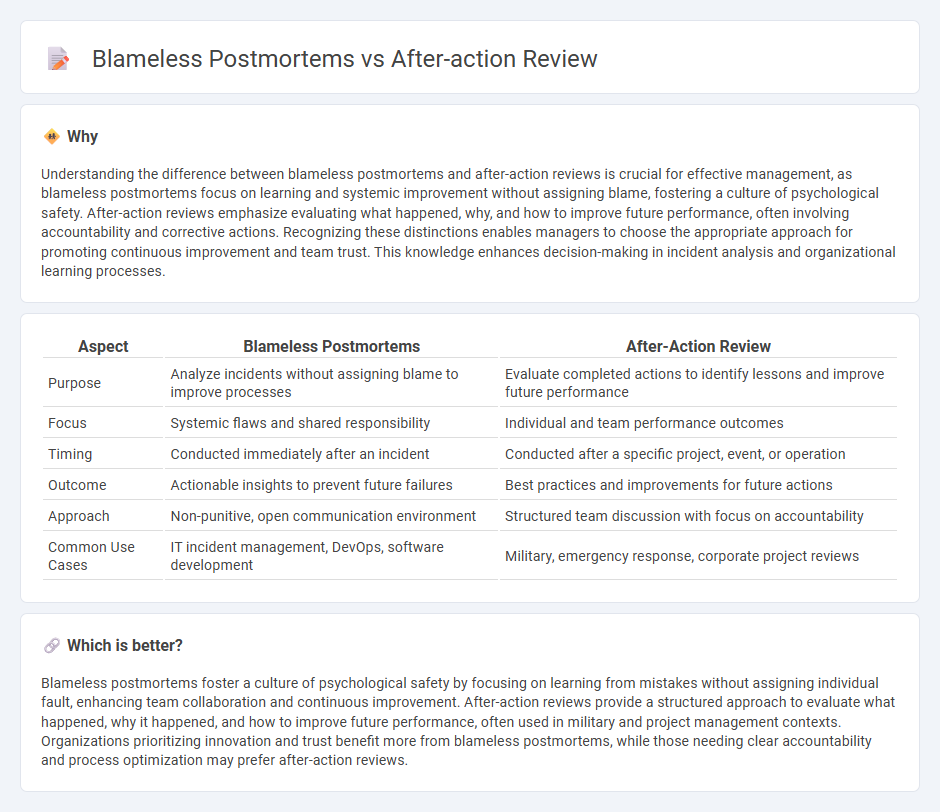
Blameless postmortems focus on identifying system failures without attributing individual fault, promoting a culture of learning and continuous improvement in management practices. After-action reviews systematically evaluate what occurred, why, and how to enhance future performance, often involving accountability alongside constructive feedback. Explore more to understand how these approaches can transform organizational effectiveness.
Why it is important
Understanding the difference between blameless postmortems and after-action reviews is crucial for effective management, as blameless postmortems focus on learning and systemic improvement without assigning blame, fostering a culture of psychological safety. After-action reviews emphasize evaluating what happened, why, and how to improve future performance, often involving accountability and corrective actions. Recognizing these distinctions enables managers to choose the appropriate approach for promoting continuous improvement and team trust. This knowledge enhances decision-making in incident analysis and organizational learning processes.
Comparison Table
| Aspect | Blameless Postmortems | After-Action Review |
|---|---|---|
| Purpose | Analyze incidents without assigning blame to improve processes | Evaluate completed actions to identify lessons and improve future performance |
| Focus | Systemic flaws and shared responsibility | Individual and team performance outcomes |
| Timing | Conducted immediately after an incident | Conducted after a specific project, event, or operation |
| Outcome | Actionable insights to prevent future failures | Best practices and improvements for future actions |
| Approach | Non-punitive, open communication environment | Structured team discussion with focus on accountability |
| Common Use Cases | IT incident management, DevOps, software development | Military, emergency response, corporate project reviews |
Which is better?
Blameless postmortems foster a culture of psychological safety by focusing on learning from mistakes without assigning individual fault, enhancing team collaboration and continuous improvement. After-action reviews provide a structured approach to evaluate what happened, why it happened, and how to improve future performance, often used in military and project management contexts. Organizations prioritizing innovation and trust benefit more from blameless postmortems, while those needing clear accountability and process optimization may prefer after-action reviews.
Connection
Blameless postmortems and after-action reviews are connected through their focus on fostering a culture of continuous improvement by analyzing failures without assigning blame. Both practices emphasize transparent communication and collective learning to identify systemic issues and enhance organizational processes. Implementing these methods leads to more effective problem-solving and resilience within teams.
Key Terms
Reflection
After-action reviews emphasize structured reflection by analyzing what occurred during an event to identify strengths and areas for improvement without assigning blame. Blameless postmortems prioritize psychological safety, encouraging teams to openly discuss failures and systemic issues to foster learning and continuous improvement. Explore the nuances of these approaches to enhance your team's reflective practices.
Accountability
After-action reviews emphasize identifying individual and team responsibilities to ensure accountability and improve future performance, while blameless postmortems foster a culture of psychological safety by analyzing system failures without attributing fault. Effective accountability in after-action reviews can drive immediate corrective actions, whereas blameless postmortems encourage long-term learning and continuous improvement through constructive feedback. Explore detailed comparisons to understand how each method impacts organizational accountability and culture.
Continuous Improvement
After-action reviews emphasize immediate feedback to enhance team performance by analyzing actions and outcomes in a structured manner, while blameless postmortems foster a culture of psychological safety by focusing on system failures rather than individual mistakes to drive continuous improvement. Both methodologies aim to identify root causes and implement corrective measures, but blameless postmortems encourage open dialogue without assigning blame, leading to more effective learning from incidents. Explore detailed strategies to optimize your team's continuous improvement process through these approaches.
Source and External Links
What are After Action Reviews (AARs)? [Free Template] [2025] - Asana - An after action review is a tool to debrief a project by answering four key questions that reveal what was expected, what happened, what went well, and how to improve, culminating in a report with actionable recommendations for future projects.
After Action Review in Project Management - PM4DEV Blog - An AAR is a simple, open, blame-free group reflection process where teams analyze what was intended, what occurred, and what lessons can improve future performance after a project cycle or milestone.
After-action review - Wikipedia - The after action review is a technique originally developed by the U.S. Army for improving process and execution by comparing intended versus actual outcomes and focusing on participants' actions to inform future improvements without assigning blame.
 dowidth.com
dowidth.com